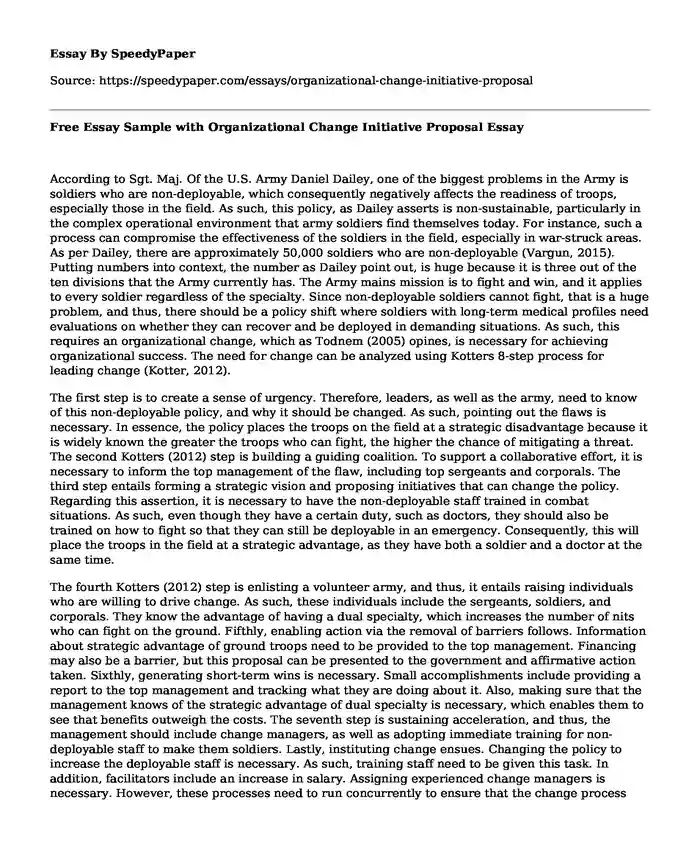
| Type of paper: | Essay |
| Categories: | Management |
| Pages: | 3 |
| Wordcount: | 685 words |
According to Sgt. Maj. Of the U.S. Army Daniel Dailey, one of the biggest problems in the Army is soldiers who are non-deployable, which consequently negatively affects the readiness of troops, especially those in the field. As such, this policy, as Dailey asserts is non-sustainable, particularly in the complex operational environment that army soldiers find themselves today. For instance, such a process can compromise the effectiveness of the soldiers in the field, especially in war-struck areas. As per Dailey, there are approximately 50,000 soldiers who are non-deployable (Vargun, 2015). Putting numbers into context, the number as Dailey point out, is huge because it is three out of the ten divisions that the Army currently has. The Army mains mission is to fight and win, and it applies to every soldier regardless of the specialty. Since non-deployable soldiers cannot fight, that is a huge problem, and thus, there should be a policy shift where soldiers with long-term medical profiles need evaluations on whether they can recover and be deployed in demanding situations. As such, this requires an organizational change, which as Todnem (2005) opines, is necessary for achieving organizational success. The need for change can be analyzed using Kotters 8-step process for leading change (Kotter, 2012).
The first step is to create a sense of urgency. Therefore, leaders, as well as the army, need to know of this non-deployable policy, and why it should be changed. As such, pointing out the flaws is necessary. In essence, the policy places the troops on the field at a strategic disadvantage because it is widely known the greater the troops who can fight, the higher the chance of mitigating a threat. The second Kotters (2012) step is building a guiding coalition. To support a collaborative effort, it is necessary to inform the top management of the flaw, including top sergeants and corporals. The third step entails forming a strategic vision and proposing initiatives that can change the policy. Regarding this assertion, it is necessary to have the non-deployable staff trained in combat situations. As such, even though they have a certain duty, such as doctors, they should also be trained on how to fight so that they can still be deployable in an emergency. Consequently, this will place the troops in the field at a strategic advantage, as they have both a soldier and a doctor at the same time.
The fourth Kotters (2012) step is enlisting a volunteer army, and thus, it entails raising individuals who are willing to drive change. As such, these individuals include the sergeants, soldiers, and corporals. They know the advantage of having a dual specialty, which increases the number of nits who can fight on the ground. Fifthly, enabling action via the removal of barriers follows. Information about strategic advantage of ground troops need to be provided to the top management. Financing may also be a barrier, but this proposal can be presented to the government and affirmative action taken. Sixthly, generating short-term wins is necessary. Small accomplishments include providing a report to the top management and tracking what they are doing about it. Also, making sure that the management knows of the strategic advantage of dual specialty is necessary, which enables them to see that benefits outweigh the costs. The seventh step is sustaining acceleration, and thus, the management should include change managers, as well as adopting immediate training for non-deployable staff to make them soldiers. Lastly, instituting change ensues. Changing the policy to increase the deployable staff is necessary. As such, training staff need to be given this task. In addition, facilitators include an increase in salary. Assigning experienced change managers is necessary. However, these processes need to run concurrently to ensure that the change process becomes faster.
References
Kotter, J. (2012). The 8-step process for leading change. Kotter International. Retrieved from http://www.esc20.net/users/0077/docs/TTESS/Lead%20Meetings/05.11.16/The%208%20Step%20Process%20for%20Leading%20Change.pdf
Todnem By, R. (2005). Organizational change management: A critical review.Journal of change management, 5(4), 369-380.
Vergun, D. (2015). Dailey: non-deployable Soldiers No.1 problem. The United States Army. Retrieved from https://www.army.mil/article/158897/Dailey__Non_deployable_Soldiers_No_1_problem
Cite this page
Free Essay Sample with Organizational Change Initiative Proposal. (2019, Oct 15). Retrieved from https://speedypaper.net/essays/organizational-change-initiative-proposal
Request Removal
If you are the original author of this essay and no longer wish to have it published on the SpeedyPaper website, please click below to request its removal:
- Free Essay: Recommended PPM-based Growth Strategies for Wedding SMEs in Korea
- FreeEssay Sample on Maslow and Cast Away Movie
- Essay Example on Website Security and Vulnerability Assessment
- Adolescent Interview - Free Essay in Psychology
- Free Essay on Logistics Management (Effective Management Strategies)
- Integrated Care and LGBT - Literature Review Essay Sample
- Free Essay Sample on Red Tide Solution
Popular categories




